50 Art Ideas in an Art Journal
This week I have a special treat for you: a flip-through video of my full Dylusions Creative Journal. It has 50 art ideas, not only for art journaling but for art-making in general.
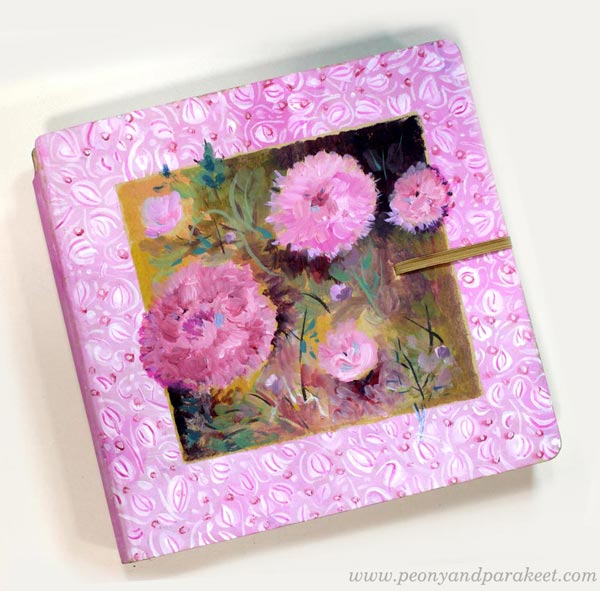
The pages are mostly made with colored pencils, watercolors, and acrylic paints. I also have many that have hand-drawn collage pieces.
I started the journal in 2020 and finally finished it now in 2025. There are so many memories saved in it. But I didn’t want the nostalgy to take over, but tried to make the video as useful and as easy to watch as possible.
50 Art Ideas – Watch Now!
There’s so much ideas that I thought it would be handy for you to have all the ideas and links listed.
List of Art Ideas and Links to Related Content
#1 Borders
Get inspiration from books and paint covers so that they have borders.
#2 Draw a Tassel!
Draw a decorative object like a tassel rather than an animal or a person.
Blog post: Making the Art Journal More Magical
Course: Animal Inkdom
Course: Magical Inkdom
#3 Forgotten Supplies
Check what supplies you have and use those that you haven’t used for a very long time. At the same time you can decide if you really want to keep them.
Blog post: Art Supplies I Should Not Use Anymore
#4 Introduce Yourself!
Tell who you are in words and pictures.
#5 Title
Give the book a title that inspires you.
Blog post: Adding Text and Layers to Your Pages
#6 Makeover
Paint over any page so that the previous layers show through. Then add details on top of everything.
#7 Alice in Worderland
Paint a place where strange things happen.
Blog post: Painting a Mystery
Blog post: Wonderland Art – Inspiration from Alice in Wonderland
#8 Indoors and Outdoors
Paint a room with large, open windows. Imagine that the outside world floods in.
Blog post: Painting a Mystery
#9 Cafe Bakery
Imagine a lovely cafe where you bake cakes.
Course: Decodashery
#10 Paint with Pencils
Use colored pencils like they are paints and color without outlines.
Course: Intuitive Coloring
#11 Child’s Drawing
Use a child’s drawing as a starting point for a page.
#12 Hole
Make a window from one page to another by cutting a hole.
#13 Scribbles
Pick a black pen and scribble and doodle your heart out. Then use the drawing as a coloring page.
Blog Post: Don’t Just Create Circles
Blog Post: Doodler’s Sampler Step by Step
#14 Transparency
Draw on a transparent film or print your drawing on the film.
Blog post: Creating Wood by Doodling Layers
#15 Safari
Draw animals and use unconventional colors and details.
Course: Animal Inkdom
#16 Time Travel
Combine your art from several years into one spread.
#17 Happy
Collect happy things and write comforting and hopeful thoughts.
Blog post: Mini Drawings on Art Journal Pages
#18 Inner Child
By creating, we cherish our inner child. Let her face appear in one of your pages.
Blog post: Coloring with the Inner Child
#19 Columns
Add drawings and paintings as vertical stripes on the spread.
#20 Free Video: Colored Pencils – Intuitive Approach
Blog post: Colored Pencils – Intuitive Approach
#21 Underwater
Let blue tones dominate the background and create an underwater scenery.
#22 Nighttime
Imagine what can happen in the night when no one is watching.
#23 Fairytale
Make up a fairy tale while you draw.
Blog post: Picture Prompts – Creating Art Journal Pages with Handdrawn Animals
Course: Animal Inkdom
#24 Wings
You can draw wings on almost anything.
Blog post: Picture Prompts – Creating Art Journal Pages with Handdrawn Animals
Blog post: Angel Drawing for the Inner Child
Course: Magical Inkdom
#25 Four Seasons
Express spring, summer, fall, and winter in one spread.
#26 Seed Flower
Start with a single flower.
Blog post: Flower for Your Art Journal
Blog post: Expressive Watercolor Flower Collage
#27 Floralize!
Leave some happy parts of bad art visible and then paint flowers on the top.
More ideas for revamping:
Blog post: Revamp Art Journal Pages So That They Spark Joy!
Blog post: Revamping Watercolor Painting with Watercolor Pencils
Blog post: Art Makeover – Revamp Your Old Paintings!
#28 Carve & Stamp!
Carve a lino plate and use it as a stamp.
You can also use a gelli plate.
Blog post: Gelli Plate Meets Fine Art – Monoprinting Ideas for Art Lovers
#29 Lemons
Express your appreciation for lemons or other fruits by painting or drawing them.
Blog post: Painting And Drawing Fruits
Course: Fun Botanicum
#30 Vermeer Girl
Re-create the face from Johannes Vermeer’s painting Girl with Pearl Earring.
Blog post: Vermeer Girl with Heart – Draw with Me!
#31 Glow
Make a drawing that glows without using any glitter. Use soft transitions from light to dark.
Blog post: Bringing Old-World Feel to Abstract Painting
#32 Spirit
Visualize the person’s spirit, not only the face.
Blog post: Intuitive Art Journaling
Blog post: Coloring an Intuitive Selfie
#33 Puzzle
Glue a couple of small drawings on the page and continue their outlines so that they form a new image.
Blog post: Mini Drawings on Art Journal Pages
#34 Easy Start
Paint the background with watercolors and then use it as an inspiration for coloring.
Blog post: Why Draw in the Ready-Made World?
#35 Stripes
Paint stripes of your current favorite colors.
#36 Scan, Print, Collage!
Scan your drawings and print them smaller. Use the printed images for a fun collage with stripes.
Blog post: Making the Art Journal More Magical
Course: Magical Inkdom
#37 Block
Paint rectangles and triangles to make a design.
Blog post: Building and Breaking – Revealing Artistic Potential
Blog post: Art Quilts in a Modern Way
About Paul Klee
Blog post: Paul Klee and the Art of Learning
Course: Floral Freedom
#38 Chapter
Make a themed chapter of several pages for your art journal.
Course: Hearts and Stories
Course: Fun Botanicum
#39 Storybook
Make a storybook page.
Blog Post: Art Journal as a Storybook
#40 Childhood Memories
Get inspired by your childhood and draw things you loved back then.
Blog post: Maximalist or Minimalist? Style Experiments in Art Journal Pages
Blog post: Choosing the Word for 2025
#41 Dolls
Rather than drawing a realistic person, design a doll with all the accessories.
Course: Decodashery
Course: Doll World
#42 Dark Background
Make an impact with the contrast between bright flowers and dark background color.
Blog post: Imagining Flower’s Spirit
#43 From Back to Front
Add more than one color to the background and, at the same time, adjust the shape of the foreground objects.
Course: Freely Grown
Course Wild Garden
#44 Modern
Make organic shapes more angular and thus more abstract and modern.
Blog post: Making Florals More Modern
#45 Letters
Imagine that the letters are fictional characters and add expression and decorations to them.
Blog post: Making the Art Journal More Magical
Blog post: Draw Your Own Fonts
#46 Watercolor Love
Paint flowers with watercolors.
Course: Wild Garden
Course: Freely Grown
#47 Castle
Imagine a building that is full of fun details.
Blog post: Intuitive Art Journaling
#48 Experience
Imagine being in an imaginary place.
Blog post: Intuitive Art Journaling
#49 More Is More
Be a maximalist, and get inspired by nature’s abundance.
Blog post: Maximalist or Minimalist? Style Experiments in Art Journal Pages
Blog post: Following the Inner Color
#50 Jewelbox
Divide the page into small compartments and color the compartments one by one.
Need More Than These 50 Art Ideas?
See the blog post from 2020: 75 Ideas in an Art Journal
I hope you enjoyed this post and put the art ideas in use. Let’s keep creating!
Making Florals More Modern
This week, we are making florals more modern! So, when you want to get away from a botanical look, and draw and paint flowers that are more abstract and expressive, here are my tips for you!
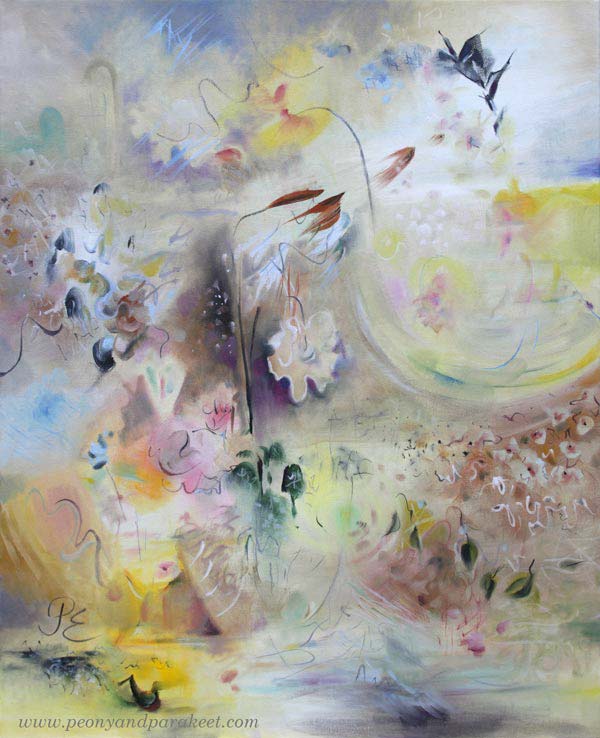
In my recent painting Gossamer, I have stretched my style to a modern direction. The painting was born much faster than usually if you count the actual painting time only. But that’s not the whole truth because I practiced this style several times. You too, can make your florals more modern in this way!
#1 Choose Your Muse!
Pick a painter that has a modern abstract style for flowers.
My choice was Helene Schjerbeck (1862-1946). She was a famous Finnish modernist, and even if I find many of her paintings a bit too melancholic, her style fascinates me.
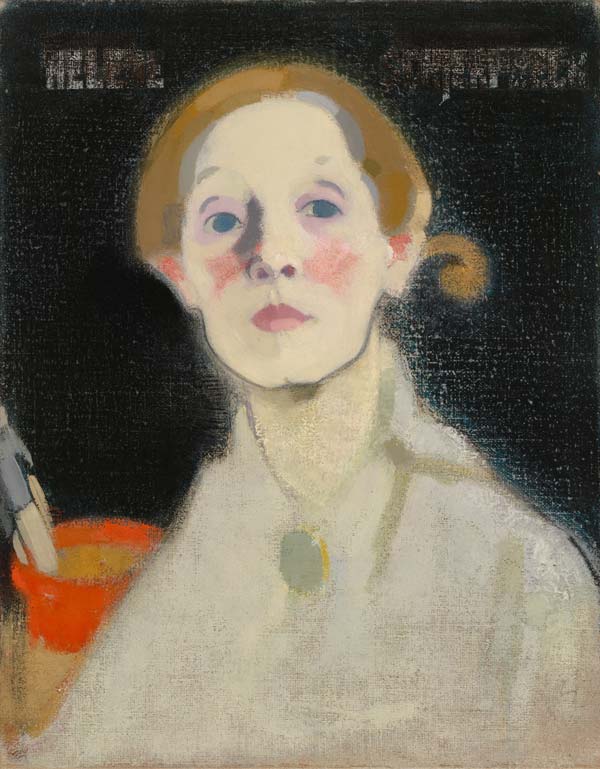
Helene is more of a portrait painter, but she also painted many still lives. (By the way – I also have a blog post about mimicking Helene Schjerfbeck’s style in portraits in colored pencil.)
#2 Make Many Tiny Sketches on One Page
Paint or draw small sketches where you pick ideas from your muse’s paintings. Combine many paintings on one page. When the size is small, you need to simplify and thus, find the core of your muse’s modern style.

I examined several Helene Schjerfbeck’s paintings in watercolor and combined them on one art journal page.
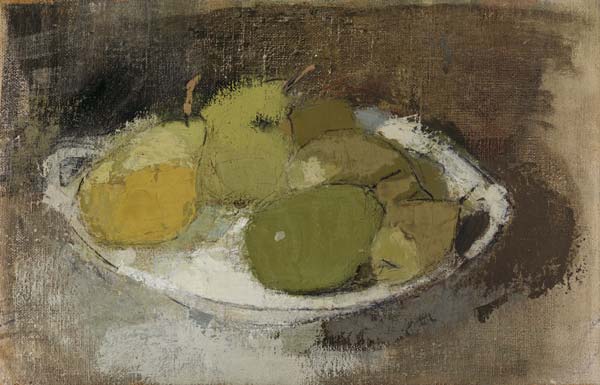
Focus on the shapes and lines and answer to these questions while working:
- Are the muse’s shapes light or heavy?
- How angular are the single strokes?
- How light and shadows are expressed?
- Where can you find playfulness and creativity?
Helene Schjerfbeck’s shapes are rather heavy, and her strokes are quite angular. The light and shadows are treated like they are objects as well. The result is a puzzle where the material and immaterial are treated identically.
I didn’t first think that Helene’s paintings are playful, but when I browsed more of her paintings, I started to see humor in the way she painted the shadows. There is something human in their shapes. It is shown brilliantly in this piece “Trees and Sunset.”
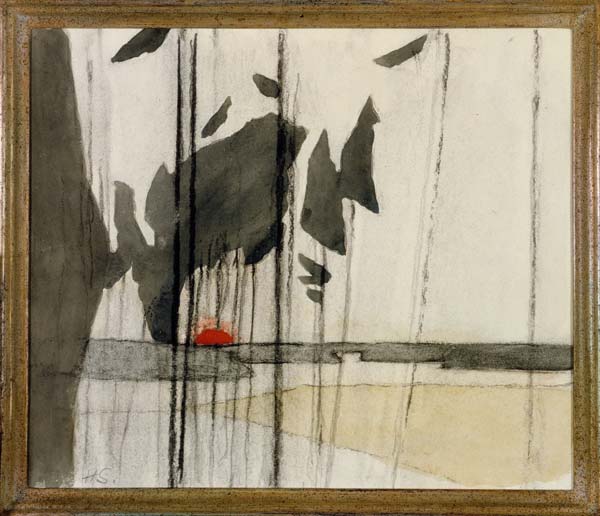
I started to think that maybe for my muse, the shadows were like animals, or dolls, and that they could be a little like toys in my paintings too.
#3 Create a Bigger Study More Freely
Next, use your observations to create a bigger study. Work freely and mix the observations with your original style.

I used left-over oil paints and made this spread for my Dylusions Creative Journal. I really like how playful the shadows are, and painting this was a lot of fun!
In the detail pic below, you see how angular my strokes are.
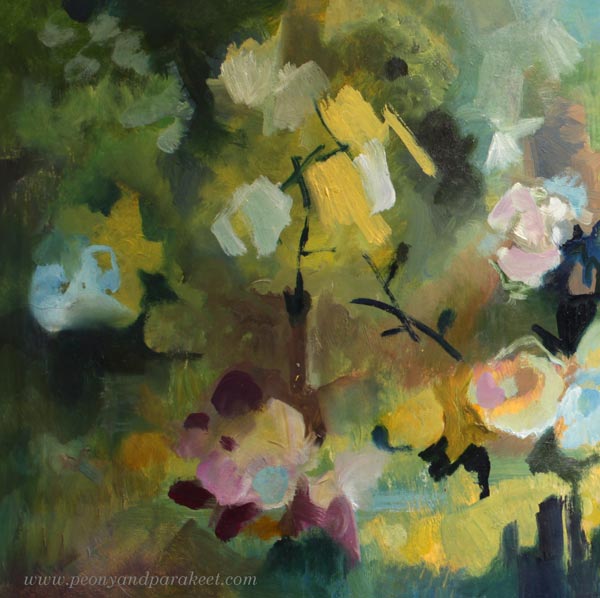
When searching for images for this blog post, I found this small painting from Helene Schjerfbeck. My flowers are different, but still there are similarities as well.

My best tips for making florals more modern:
- While working, think about surface patterns in interiors and clothing rather than the actual flowers.
- Use angular strokes to build puzzle-like compositions.
- Similarly to the parts of the colorful flowers, see the shadows and light as the shapes of the puzzle.
#4 Make the More Modern Piece
After practicing, you can now create a piece where you spend more time for finishing. Modern strokes often appear quick and careless, but they are still packed with aesthetics and style. Those kind of strokes can take a lot of attention and focus.
Here’s a pic from the early stage of my painting Gossamer. I started with a narrow color scheme, and many of the shapes and strokes were more like suggestions – a whispering start, you could say!
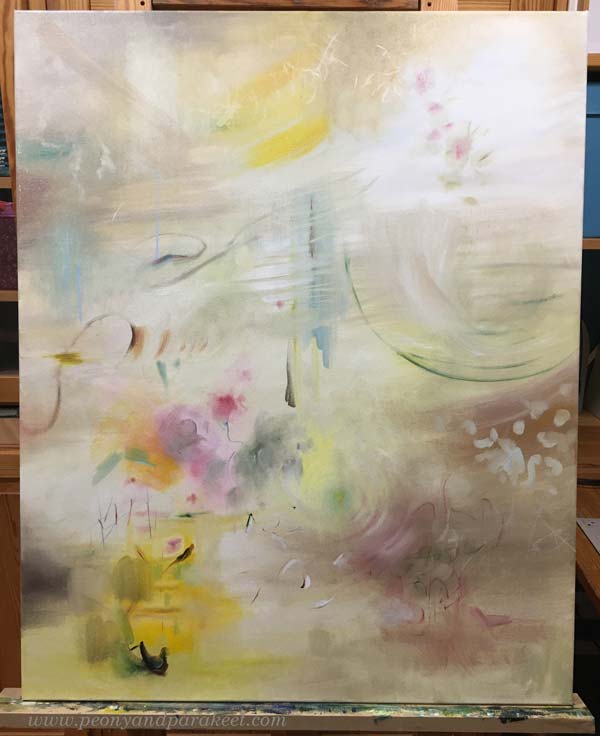
In the finished piece, I especially enjoy the playful color changes in the background and the new playfulness is present in lines too.

#5 Old and New – Compare!
Here you can see my previous painting of the same size and the finished Gossamer side by side. The styles of the two paintings are slightly different, but not totally!
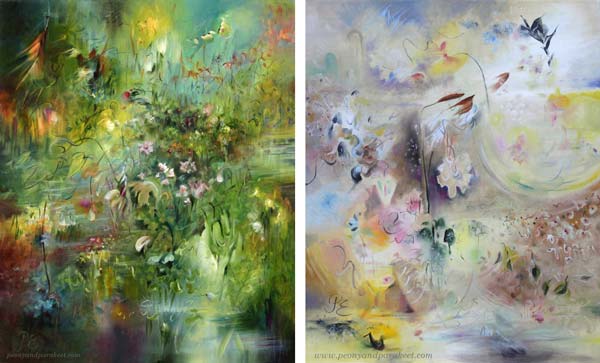
I used leftover paints for these two miniature paintings. The one on the left is more of my original style, the other one is more modern.
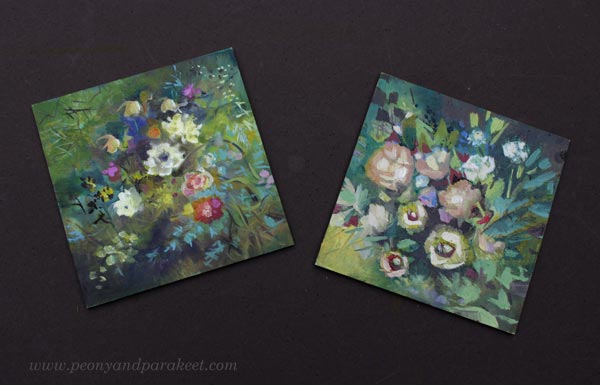
If the weather allows, I always take the photo of the final piece outdoors. This fall has been exceptionally long and warm. There are still leaves in the apple tree, and it’s November!
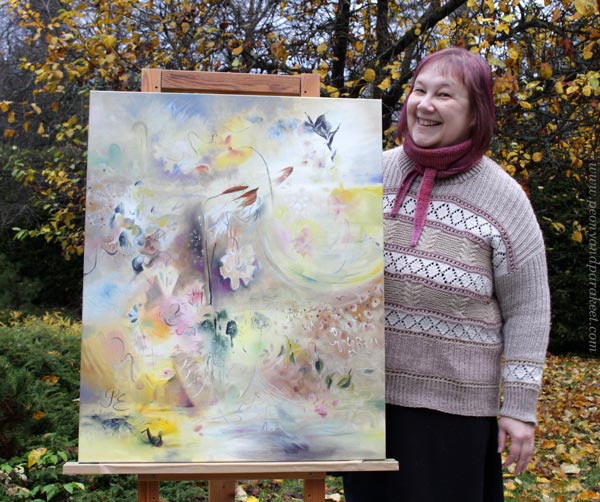
I hope you enjoyed this little tutorial on how to make florals more modern!
Following the Inner Color
Here is my latest completed oil painting “Elixir.” I start my abstract paintings with the idea that I follow an inner color.

Color Chooses Color
The inner color is the color I feel drawn to, so I tend to pick and mix the first colors intuitively. And then, they wish for other colors to accompany them.

Colors also evoke shapes, and the shapes bring in more colors. A raw and bright color selection changes slowly to a more sophisticated one. In this color-driven technique, the inner color changes as the painting matures.

I try to give my painting enough time to find its own soul and paint several sessions, letting the paint dry between them.
First a Child, Then a Teenager
When the painting is only a child, I don’t care about the composition or what it will represent. I don’t want to force a short childhood or early adolescence. When puberty begins, it’s tempting to call the painting finished. But only then does she begin to find her own, unique mission and get prepared for a long life.
Teenagers often tell how they want to be called. When this painting was still unfinished, she was Ophelia because she saw herself as John Everett Millais’s painting from the 19th century.

I usually give the final name only when the painting is almost finished. Then I know what I want to emphasize with the name. Maybe we humans should get our final name a little later too?
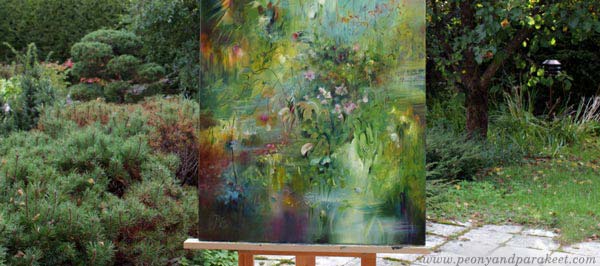
Early Goodbye
I take pictures of my canvas paintings outside if possible, because that’s where the light is most natural. My husband often acts as my assistant and holds the painting against the wind. Most of the time, I end the photoshoot by saying to him, “Hey, come take a picture of us together!”

Since I sell all my paintings, this is the moment when I’m saying a mental goodbye to them. I assure them: “You’ll be fine. Everything’s going to be fine.” Even though I often miss my paintings, I don’t tell them. I feel like their mission is bigger than mine, and my job is to deliver all this for others, not for myself.
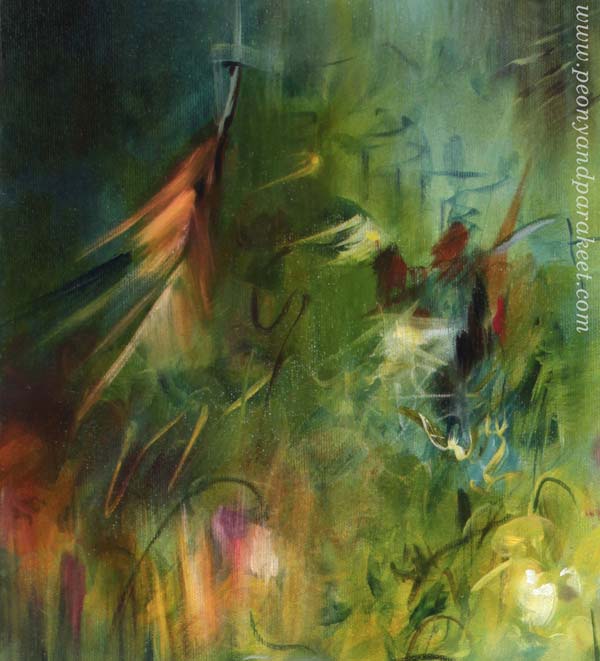


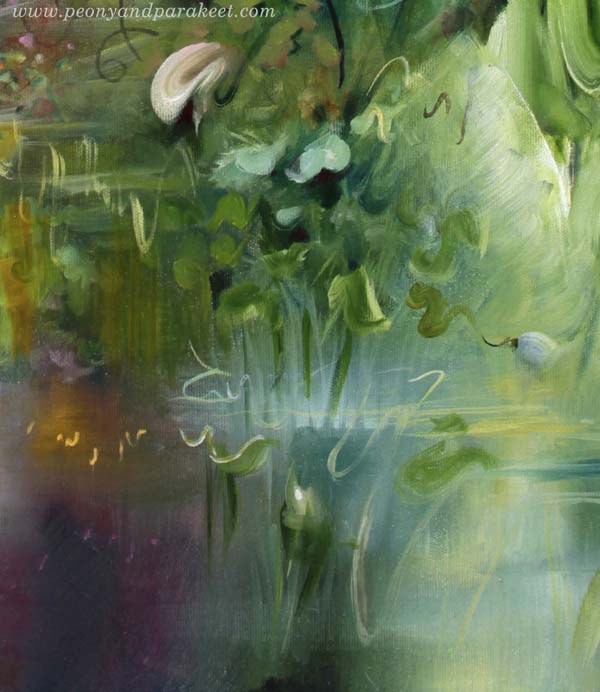
I have practiced most of my oil painting techniques in a quicker medium, so in watercolor!
Wild Garden – You Can Still Hop in!
In Wild Garden, we will paint freely, intuitively, and expressively in watercolor from Sept 22 to Nov 14. We will begin with floral greeting cards and gradually move forward in expression.

The course has just started but you can still hop in!
>> Sign up now!
Half-Empty Art Journals I Should Fill Up
Last month, I went through my art supplies and wrote a post about the supplies I shouldn’t use anymore. After the post, I gave most of those useless-to-me supplies away. Now I have reviewed my art journals and have come to the conclusion that I have too many half-empty ones. I should fill these up and at the same time, end one era in my artistic journey.

I don’t mean I shouldn’t have any art journals or sketchbooks anymore, but I think I could do well with only one or two. I have grown my skills by drawing a lot, but now I feel I am more of a painter. Most of my creative energy nowadays goes into painting, and I mostly make either watercolor or canvas paintings. So, the books don’t serve me as much as they have in the early years.
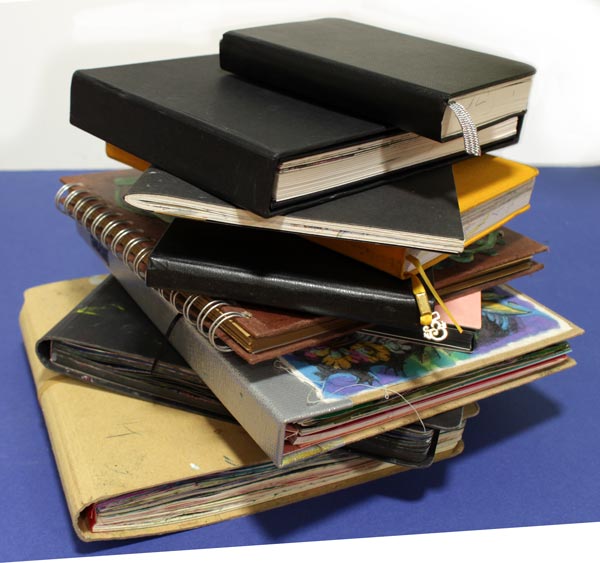
Ten of my art journals are half-empty. I don’t think it’s realistic to fill them in a short time. On the other hand, I have small pieces and hand-drawn motifs that I could attach to the pages and make collage art. Anyway, I wanted to share my inventory. Time will tell how quickly these will be filled!
Art Journal #1 – Smash Book
Who remembers the Smash Books by K&Company? I have several, but only one of them is unfinished. This one has the best cover as I have attached my fabric drawing to it.

This journal has all kinds of pages, but I want to show you the spread that has slow stitching. I have just glued the hand-embroidered fabrics on the pages.
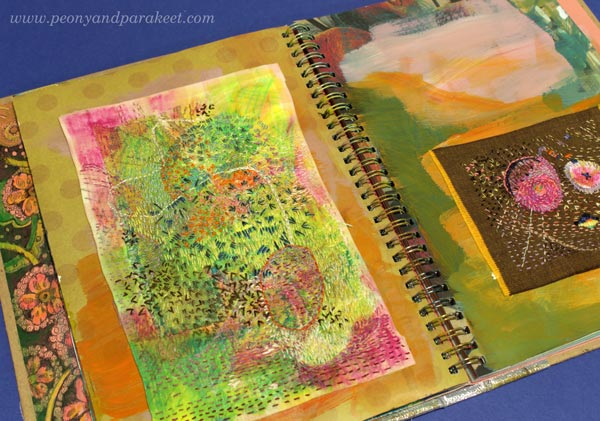
Maybe I could continue this journal with the fabric theme and search for other hand-embroidered pieces from my needlework stash?
Art Journal #2 – Accordion Book
This art journal is really fancy. It’s an accordion book with a separate casing. The paper holds watercolor well but it’s smooth enough for drawing and coloring too. I have got this as a gift from a student of my courses.
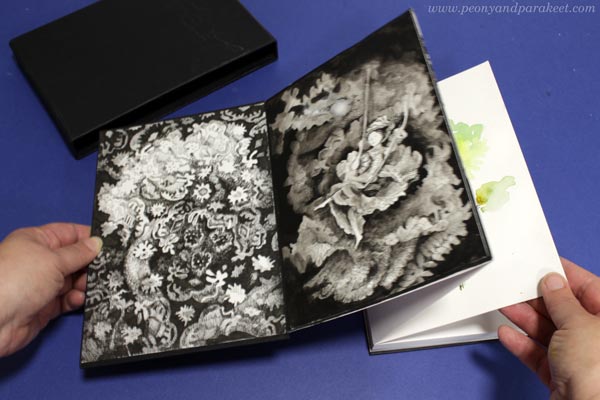
This journal has quite a many filled pages, but as it’s an accordion book, I could fill the rest of the pages with a watercolor painting that would continue from one page to another.
Art Journal #3 – Spiral Bound Sketchbook
I shared the process of making the collage cover in this blog post from 2020.

When I start making a new course, I often buy a new sketchbook, and that’s what happened here too. This book has mostly portrait drawings. They were drawn when practicing and gathering ideas for the course Innovative Portraits. Some portraits are very abstract like the one below.
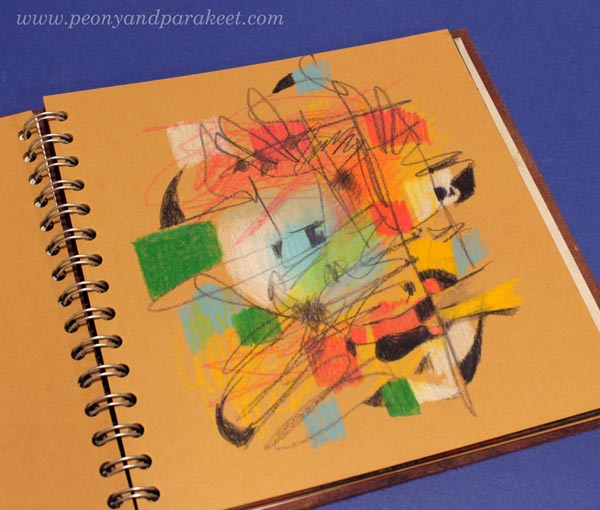
This book has still many empty pages. Here, I could gather other face drawings that I have made over the years. I think that at some point, every artist wants to draw faces.
Art Journal #4 – Small Sketchbook
Most of my art journals are filled with colorful art and contain fairly little writing or black-and-white sketches. This little sketchbook has some interesting ideas and it’s more like a notebook about art-making.
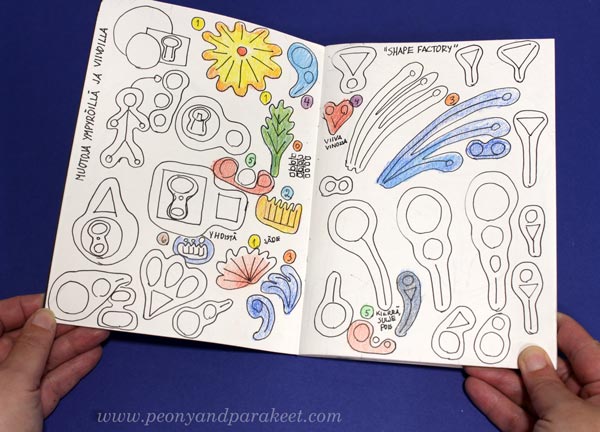
This sketchbook is almost full, and could be filled very quickly with the ideas for the upcoming paintings and courses.
Art Journal #5 – Colored Pencil Diary
This journal is an Archer & Olive Notebook that I call my colored pencil diary. I have filled many pages already. For example, see the blog post about coloring without limits!

My favorite part of the book is the chapter that has fun plant-themed pages. I made them for the course Fun Botanicum.

Even if this journal has many filled pages, it still has a lot of blank pages. However, I feel the journal is ready to be called finished. Should I remove the blank pages? What do you suggest?
Art Journal #6 – Bullet Journal
I love bullet journals but don’t usually draw in them. However, in 2018-2019 I bought a dot-grid journal just for small drawings. These became inspiration pieces for the course Animal Inkdom.

The drawings leave room for writing, and there are many empty pages left. I think I should remove this journal from my art journal shelf and use it for bullet journaling once my current bullet journal gets full.
Art Journal # 7 – Tiny Sketchbook
My smallest art journal is still quite empty. It has some lovely drawings, though!

Should I continue this, or just take out the pages and glue them on another art journal? When I carry a journal with me, I prefer a bigger one.
Art Journal #8 – Dylusions Creative Journal Square with Black Pages
Dylusions Creative Journals are sturdy and their paper is quite thick. I like to practice painting by filling their page. Black is a nice background, especially when I use leftover paints from the palette.
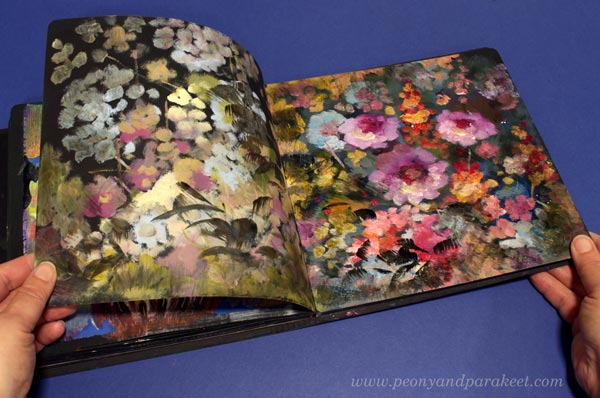
This is the kind of journal I still want and need. It will get filled over the years and there’s no pressure to do it right away.
Art Journal #9 – Moleskine Watercolor Notebook
Moleskine watercolor notebook is a small journal, but it has lovely panorama spreads and nice paper. See this blog post for more inspiration!
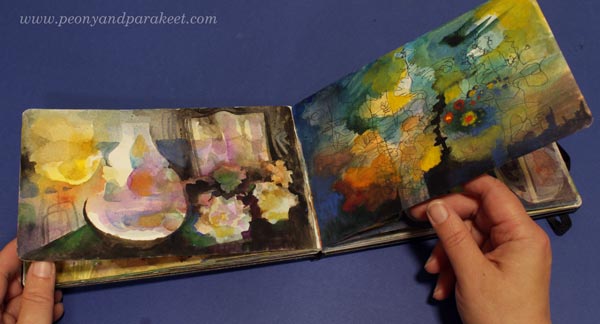
I am going to continue this one, for sure!
Art Journal #10 – Dylusions Creative Journal Square with Cream Pages
Dylusions Creative Journal with cream-colored pages is my favorite art journal. This journal works well with colored pencils, for example, see this drawing tutorial of Vermeer Girl!
The inside cover is colored freely with felt-tipped pens. I used thin marker paper for the drawing and then glued the paper on the cover.
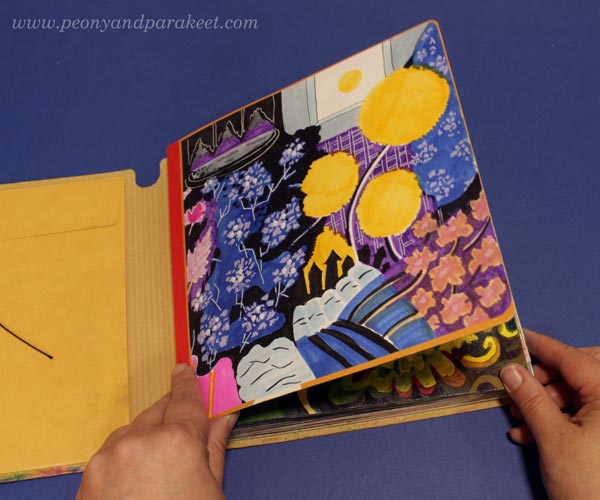
I started this journal about five years ago, and have almost filled it. But I like to keep working on the older pages, making them more beautiful. Like with the black journal, leftover paints find their way here.
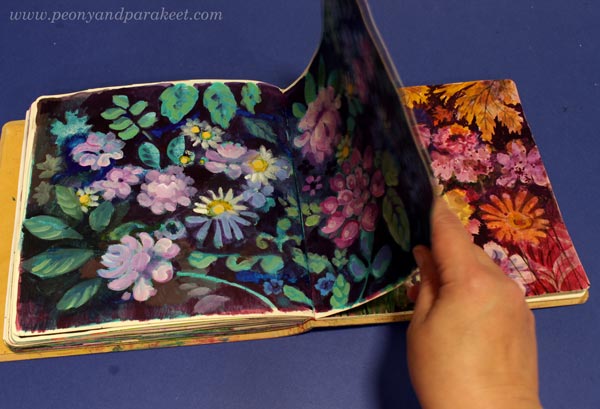
The paper holds water fairly well, and I use watercolors, acrylics, and oils there. I only wish that the paper would be bright white, not cream-colored. When the journal is full, I will record a flip-through video of it.
Half-Empty Art Journals – Question!
I have a shelf that has many full art journals. I have now put the half-empty ones on the right, so that they don’t get mixed with the full ones.
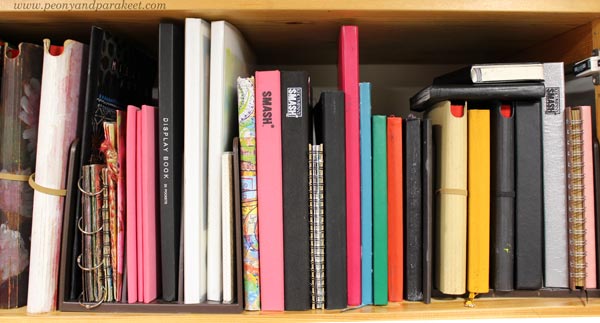
How many half-empty art journals do you have? Leave a comment!
Wild Garden – Paint with Me!
In the upcoming course Wild Garden we will paint flowers freely, intuitively, and expressively in watercolor. Watch the video and sign up now!
Wild Garden will begin on September 22, 2025. Sign up here!